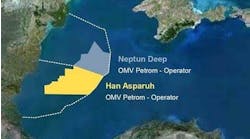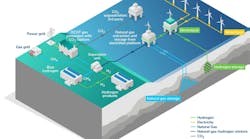Expanding the scope for well planning and drilling
William Standifird, Knowledge Systems
Anew regional pressure and stress database developed for the US Gulf of Mexico (GoM) has expanded the scope and quality of information available for planning and drilling wells. The database applies advanced pore pressure methodologies to public well logs and downhole pressure data for more definitive information that improves the safety and economics of exploration and drilling operations.
Because so much depends on these measurements, operators have needed greater data precision. That critical requirement led to development of the database, which enhances public well data through application of best practices born out of multiple joint industry projects (JIP), technical peer review by geoscientists, and thousands of hours of commercial consulting.
Over 200 GoM wells have been analyzed and thousands more are targeted using these methods. The result is a comprehensive GoM pressure and stress database, with more interpreted data types (such as pore pressure, overburden pressure, and fracture pressure), and improved data quality and dependability.
Enhanced data
The database (GoM-PSD) is a comprehensive, high-quality GoM pressure and stress dataset. Operators have indicated that the data yields advantages in their operations, such as:
• More interpreted data types;
• Higher quality data;
• Better coverage over all logged shale intervals;
• Expandability and scalability; and
• Flexible delivery.
An engineer for one large GoM operator using the database for well planning and modeling says, “Knowledge Systems Inc. (KSI) well points provide continuous pore pressure values to TD, calibrated from formation test measurements. In comparison, datasets from formation tests alone provide one, or a few, thin intervals of pore pressure.”
The company’s analyses offer a range of data, including overburden pressure (OBp) derived from density, pore pressure (Pp) from resistivity and from sonic, (Pp is interpreted based on all input and calculated data), and fracture pressure (Fp) derived from interpreted Pp.
Data quality and dependability is improved using calibration, modeling, and peer review processes. The analyses are calibrated to all available information, including formation test measurements, gas, drilling events, and mud weights. Modeling is done in accordance with industry best practices, extensive experience in commercial pressure projects, and several JIPs focused entirely on pressure prediction. A documented quality control process for each well includes peer review by pressure analysts and geoscientists.
The company’s analyses provide coverage over all logged shale intervals, compared to the limited, single-point measurements of other commercial databases. The database is expandable and scalable to specific requirements, which are available in total or in part of the existing library, and select public wells that are not in the library.
Database development
Public data is enhanced through a methodology involving multiple steps such as:
• Overburden pressure is derived using a combination of measured and modeled density and sonic data.
•Porosity sensitive measurements such as resistivity and sonic are then transformed into pore pressure, and subsequently calibrated to measured data or operational data (including mud weight, drilling events, and gas).
The analyses are then subjected to a fully-documented peer review process which results in an interpreted definitive shale pressure profile. A fracture gradient is derived from this definitive pore pressure and calibrated to leak-off tests. Several additional data integrity and quality checks are performed to conform well attribute and aesthetic properties before the final product is stored in a secure relational database.
Data can be received in several ways, depending on user requirements. The database is integrated with the company’s Drillworks geopressure and geomechanical software suite and can be provided in the Pressworks relational database format. In addition, operators can use *.las files and accompanying attribute logs, or CD, DVD, FTP, and installed databases.
The Pressworks database system is a tool for storing and managing pressure-related data from multiple sources. Through user-defined fields and queries, and the capability to access third-party databases, the system enhances multidisciplinary collaboration and well planning.
Tight integration with the Drillworks software allows Pressworks users to streamline project development through a family of software for geopressure and geomechanical analysis.•






